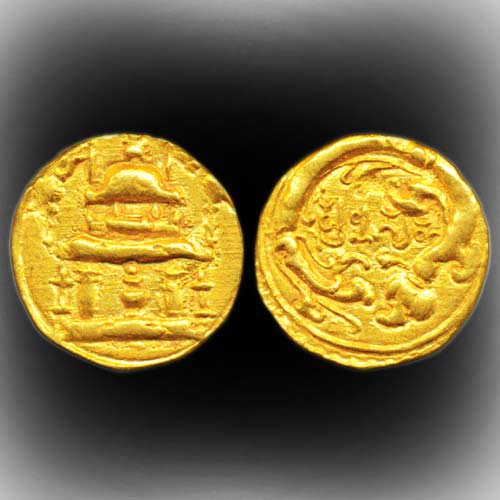This Gold Gadyana of Western Chalukyas Explains the Prominence of Shaivism from 9th to 12th Century CE
2017-10-27 Fri
The Western Chalukya Empire, also known as the Kalyani Chalukya, ruled western Deccan and southern India between the 10th and 12th centuries CE.The above shown gold Gadyana belongs to either western Chalukyas or Feudatories. The obverse of this coin depicts Shaivite temple with architectural features like pillars, Vimana and Shikhara. Two banners and two temple-lamps are flanking above it within the line and dotted border.
The reverse of this coin depicts a floral scroll emanating out from a Sankha shell with Hale-Kannada inscription in the centre which starts with word ‘Punya’ within the line and dotted border. Shaivism dominated the political environment from 9th to 12th century CE in India. Its influence can be seen on coins by the choice of the depiction of a Shaivite temple.
Sankha illustrated on the reverse of this coin is also associated with generosity and abundance of resources. The legend of this coin is assumed to be a merit associated with the issuer who helped to build this temple.
To know more about Chalukya coin click here
Latest News
-
Malwa Sultan Ghiyath Shah Silver Coinage
2025-10-31 FriMalwa Sultan Ghiyath Shah issued two types of silver coin varieties: special issues and normal issue...
-
Commemorative Coin to mark the 200th anniversary of Rani Chennamma's victory at Kittur.
2025-10-28 TueKittur Rani Chennamma was an Indian queen of Kittur, a princely state in Karnataka. She was the firs...
-
Square Gold Tanka of Sultan Ghiyath Shah of Malwa
2025-10-27 MonGhiyath Shah ruled the Malwa Sultanate from 1456–1469 as heir apparent and from 1469–1500 as sul...
-
Ghiyath Shah as Sultan
2025-10-17 FriAfter ascending the throne of the Malwa Sultanate, Ghiyath Shah issued circular coins early in his r...
-
Malwa Sultan Ghiyath Shah Square Gold Tanka
2025-10-16 ThuMalwa Sultan Ghiyath Shah issued square gold tankas in three weight standards: Double Tanka (21.9g),...

